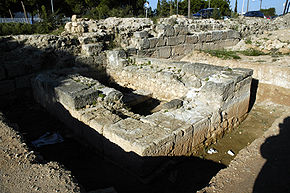Hexamilion wall
| Εξαμίλιον τείχος (Greek) | |

A preserved portion of the wall with the base of a tower.
|
|
| Location | Corinth, Corinthia, Greece |
|---|---|
| Region | Corinthia |
| Coordinates | 37°55′34″N 22°58′21″E / 37.92611°N 22.97250°ECoordinates: 37°55′34″N 22°58′21″E / 37.92611°N 22.97250°E |
| Type | Defensive wall |
| History | |
| Periods | Early Medieval to Late Medieval |
| Site notes | |
| Condition | Ruined |
| Ownership | Public |
| Management | 25th Ephorate of Byzantine Antiquities |
| Public access | Yes |
| Website | Hellenic Ministry for Culture and Tourism |
The Hexamilion wall (Greek: Εξαμίλιον τείχος, "six-mile wall") is a defensive wall constructed across the Isthmus of Corinth guarding the only land route into the Peloponnese peninsula from mainland Greece.
The Hexamilion stands at the end of a long series of attempts to fortify the Isthmus stretching back to perhaps the Mycenean period. Many of the Peloponnesian cities wanted to pull back and fortify the Isthmus instead of making a stand at Thermopylae when Xerxes invaded in 480 BC (Herodotos Histories 7.206). The issue arose again before the Battle of Salamis (Herodotos 8.40, 49, 56). Although the concept of a fortress Peloponnese was repeatedly appealing, fortification of the Isthmus was of no utility without control of the ocean, as Herodotos notes (7.138).
The wall was constructed in the period between 408 AD and 450 AD, in the reign of Theodosius II during the time of the great Barbarian invasions into the Roman Empire. The attack of Alaric on Greece in 396 AD or the sack of Rome in 410 AD by the Visigoths may have motivated the construction, which included towers, sea bastions, and at minimum one fortress. The one known fortress contained two gates (north and south), of which the northern gate functioned as the formal entrance to the Peloponessos. The wall was constructed with a rubble and mortar core faced with squared stones. It is not certain how long it took to complete, but the importance given to the task is apparent from the scale of the construction; the Hexamilion is the largest archaeological structure in Greece. Every structure in the region was cannibalized for stone for the effort, either being incorporated into the wall directly, as was the temple of Poseidon at Isthmia, or being burned into lime, as was the sanctuary of Hera at Perachora as well as much of the ancient statuary of Corinth. In the reign of Justinian, the wall was fortified with additional towers, reaching a total number of 153. Military use appears to have fallen off after the 7th century AD, and by the 11th AD domestic structures were being built into the wall. In 1415, the Byzantine emperor Manuel II personally supervised repairs over a period of forty days. The high cost of this effort caused unrest among the local elite. The wall was breached in 1423 and again in 1431 by the Ottomans under the command of Turahan Bey.Despot Constantine Palaiologos restored the wall again in 1444, but the Turks breached it again in 1446 and in October 1452. After the Ottoman conquest of the Peloponnese in 1460, the wall was abandoned. During its history, the wall never succeeded in fulfilling the function for which it was constructed, unless it acted as a deterrent. Elements of the wall are preserved south of the Corinth Canal and at the Sanctuary of Poseidon at Isthmia.
...
Wikipedia

